On December 16th, 1944, the Battle of the Bulge had begun, and forces all along the western front were being pushed back by a wave of German troops, tanks, and under bombardment from over 1,000 artillery pieces. 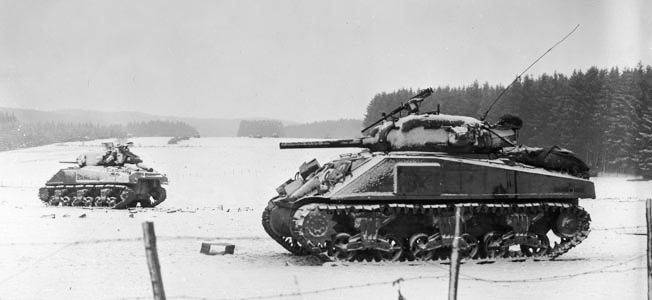 The mainstay medium tank in the US Army was the M4 “Sherman” tank, and by December 1944, U.S. armored forces were a hodgepodge of various types and upgrades of the same chassis that had been in service since 1942. For instance, a keen observer would see cast-hull M4A1s powered by 9 cylinder Continental radial engines, the welded hull M4s running both the radial engine and the 1,100 cubic inch Ford GAA V-8s, and M4A3s, which were welded hulled tanks with the Ford engine. Arriving just in time for the Battle of the Bulge,
The mainstay medium tank in the US Army was the M4 “Sherman” tank, and by December 1944, U.S. armored forces were a hodgepodge of various types and upgrades of the same chassis that had been in service since 1942. For instance, a keen observer would see cast-hull M4A1s powered by 9 cylinder Continental radial engines, the welded hull M4s running both the radial engine and the 1,100 cubic inch Ford GAA V-8s, and M4A3s, which were welded hulled tanks with the Ford engine. Arriving just in time for the Battle of the Bulge, 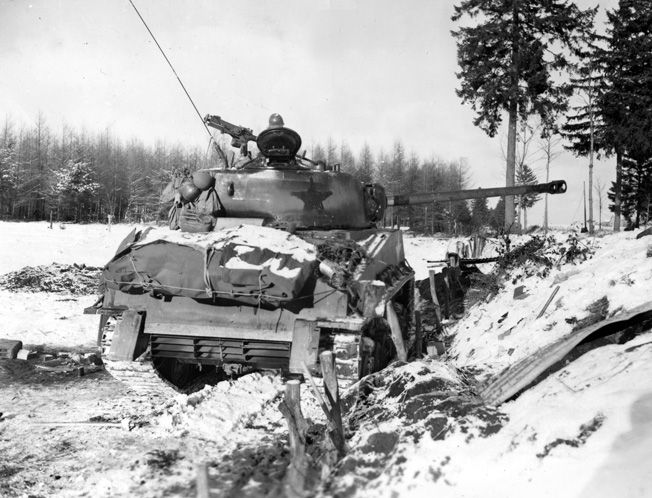 the up-armored M4A3E2 Assault Sherman, nicknamed the “Jumbo” by its crews, began arriving in depots in France. Sherman manufacturers included Chrysler, Fisher Body (who built car bodies for Cadillac, Buick, and Chevrolet among many others,) American Locomotive Company (ALCO,) Pressed Steel Car, and many others. Regardless of type or builder, most M4s were armed with the 75mm M3 gun. This gun had been gracing the turrets of the M4 Sherman since its introduction in 1942 and was considered one of the best tank-mounted guns at that time as it could lethally damage the German Panzer IIIs and IVs from over 1,500 meters from any angle. However, by late 1944, U.S. forces had run into their fair share of the bigger and more heavily armored Panther tanks, as well as low-slung StuG assault guns that the “75” couldn’t penetrate at safe ranges. A new gun was needed. At the start of Operation COBRA, the breakout from Normandy, delivery of Shermans with the new 76mm M1 started. Even though the M1 had a smaller high-explosive charge compared to the 75mm (0.9 lbs versus 1.5 lbs,) the “76” was more accurate at longer ranges, and most importantly, in a tank versus tank engagement, had more penetration at long range.
the up-armored M4A3E2 Assault Sherman, nicknamed the “Jumbo” by its crews, began arriving in depots in France. Sherman manufacturers included Chrysler, Fisher Body (who built car bodies for Cadillac, Buick, and Chevrolet among many others,) American Locomotive Company (ALCO,) Pressed Steel Car, and many others. Regardless of type or builder, most M4s were armed with the 75mm M3 gun. This gun had been gracing the turrets of the M4 Sherman since its introduction in 1942 and was considered one of the best tank-mounted guns at that time as it could lethally damage the German Panzer IIIs and IVs from over 1,500 meters from any angle. However, by late 1944, U.S. forces had run into their fair share of the bigger and more heavily armored Panther tanks, as well as low-slung StuG assault guns that the “75” couldn’t penetrate at safe ranges. A new gun was needed. At the start of Operation COBRA, the breakout from Normandy, delivery of Shermans with the new 76mm M1 started. Even though the M1 had a smaller high-explosive charge compared to the 75mm (0.9 lbs versus 1.5 lbs,) the “76” was more accurate at longer ranges, and most importantly, in a tank versus tank engagement, had more penetration at long range.
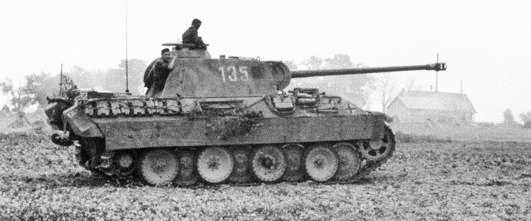 Although the number of M4s in the European theater was well over 4,000 by December 1944, the number of Shermans in the Ardennes Sector only numbered about 170, divided among three separate tank battalions (these were normally attached to infantry units, instead of the Armored Divisions.) Within hours of the start of the battle, the U.S. Army began a mass-mobilization of Armored Divisions, Tank Destroyer Battalions, and many more separate tank battalions to the Ardennes Region. IT should be added that the Sherman was supported in a scout and reconnaissance role by M5 “Stuart” light tanks armed with 37mm guns, as well as M10 and M18 Gun Motor Carriages in the Tank Destroyer Battalions.
Although the number of M4s in the European theater was well over 4,000 by December 1944, the number of Shermans in the Ardennes Sector only numbered about 170, divided among three separate tank battalions (these were normally attached to infantry units, instead of the Armored Divisions.) Within hours of the start of the battle, the U.S. Army began a mass-mobilization of Armored Divisions, Tank Destroyer Battalions, and many more separate tank battalions to the Ardennes Region. IT should be added that the Sherman was supported in a scout and reconnaissance role by M5 “Stuart” light tanks armed with 37mm guns, as well as M10 and M18 Gun Motor Carriages in the Tank Destroyer Battalions.
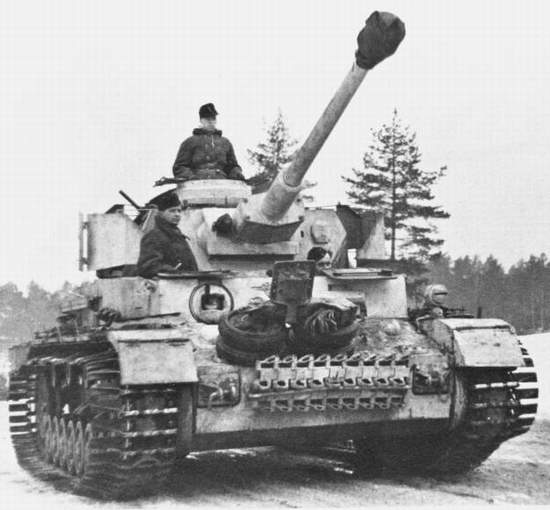 On the German side, the most numerous tank the Wehrmacht and SS Panzer Divisions fielded was the Panzer IV. This was a classic design that started rolling off the production lines in 1937, and was the only German tank in production from the beginning of the war in 1939 to its end in 1945. Much like its closest counterpart, the M4, the Panzer IV was also upgraded and updated, especially when it came to its gun. Starting with essentially a howitzer-like 75mm KwK 37 in the first models (Ausf. A through Ausf. F1,) the variants in production by the Battle of the bulge were up-gunned with long-barreled, high velocity 75mm KwK 40, which could penetrate the M4’s armor at similar ranges to the M4’s 75mm gun. The Panzer IV chassis was reliable and a good basis for many different subtypes, including StuG IV assault guns, Jagdpanzer IV and “Nashorn” tank destroyers, the “Hummel” Self-propelled gun, bridgelayers, and so on. Over 8,500 Panzer IVs of all types were built.
On the German side, the most numerous tank the Wehrmacht and SS Panzer Divisions fielded was the Panzer IV. This was a classic design that started rolling off the production lines in 1937, and was the only German tank in production from the beginning of the war in 1939 to its end in 1945. Much like its closest counterpart, the M4, the Panzer IV was also upgraded and updated, especially when it came to its gun. Starting with essentially a howitzer-like 75mm KwK 37 in the first models (Ausf. A through Ausf. F1,) the variants in production by the Battle of the bulge were up-gunned with long-barreled, high velocity 75mm KwK 40, which could penetrate the M4’s armor at similar ranges to the M4’s 75mm gun. The Panzer IV chassis was reliable and a good basis for many different subtypes, including StuG IV assault guns, Jagdpanzer IV and “Nashorn” tank destroyers, the “Hummel” Self-propelled gun, bridgelayers, and so on. Over 8,500 Panzer IVs of all types were built.
 After encountering the Soviet T-34 tank on the eastern front, with its sloped armor layout and decent firepower, Germany’s designers set to work on a new vehicle utilizing the concepts learned with the T-34. The resulting 49-ton “medium” tank, set to replace the Panzer IV, was the Panzer V, later known simply as the “Panther.” First seen at the Battle of Kursk in 1943, armed with a newly designed high velocity 75mm gun and sporting 80mm of sharply sloped frontal armor, the Panther was a force to be reckoned with…when it made it to the combat front. During the Panther’s design process, Albert Speer, Germany’s Minister of War Production and Armaments wrote; “Since the Tiger had originally been designed to weigh fifty tons but as a result of Hitler’s demands had gone up to fifty seven tons, we decided to develop a new thirty ton tank whose very name, Panther, was to signify greater agility. Though light in weight, its motor was to be the same as the Tiger’s, which meant it could develop superior speed. But in the course of a year Hitler once again insisted on clapping so much armor on it, as well as larger guns, that it ultimately reached forty eight tons, the original weight of the Tiger.”
After encountering the Soviet T-34 tank on the eastern front, with its sloped armor layout and decent firepower, Germany’s designers set to work on a new vehicle utilizing the concepts learned with the T-34. The resulting 49-ton “medium” tank, set to replace the Panzer IV, was the Panzer V, later known simply as the “Panther.” First seen at the Battle of Kursk in 1943, armed with a newly designed high velocity 75mm gun and sporting 80mm of sharply sloped frontal armor, the Panther was a force to be reckoned with…when it made it to the combat front. During the Panther’s design process, Albert Speer, Germany’s Minister of War Production and Armaments wrote; “Since the Tiger had originally been designed to weigh fifty tons but as a result of Hitler’s demands had gone up to fifty seven tons, we decided to develop a new thirty ton tank whose very name, Panther, was to signify greater agility. Though light in weight, its motor was to be the same as the Tiger’s, which meant it could develop superior speed. But in the course of a year Hitler once again insisted on clapping so much armor on it, as well as larger guns, that it ultimately reached forty eight tons, the original weight of the Tiger.”
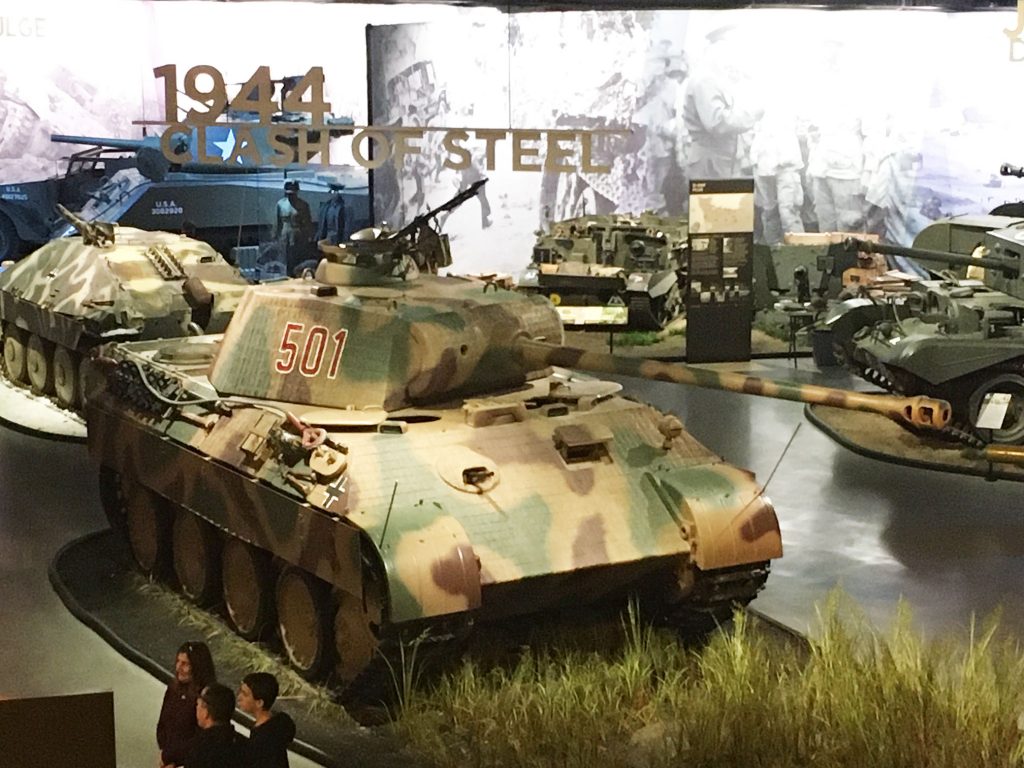 Because the engine and transmission on the Panther was never upgraded to handle the extra weight of armor, drivers for the Panther needed extra training to ensure the gearbox and drive systems would last as long as possible. This shouldn’t have been a problem as the Panthers (as well as all German tanks) were designed to be transported by rail. However, fighter-bomber attacks on standard routes and the Allied bombing campaign had been focusing on rail yards all over occupied Europe to slow German logistics as much as possible and one of the results was that the Panthers were forced to drive under their own power to the front, which drastically increased the likelihood of breakdowns along the way.
Because the engine and transmission on the Panther was never upgraded to handle the extra weight of armor, drivers for the Panther needed extra training to ensure the gearbox and drive systems would last as long as possible. This shouldn’t have been a problem as the Panthers (as well as all German tanks) were designed to be transported by rail. However, fighter-bomber attacks on standard routes and the Allied bombing campaign had been focusing on rail yards all over occupied Europe to slow German logistics as much as possible and one of the results was that the Panthers were forced to drive under their own power to the front, which drastically increased the likelihood of breakdowns along the way.
We hope that you can come visit the American Heritage Museum and see our Battle of the Bulge exhibit featuring the Jagdpanzer 38 Hetzer, M4A3 Sherman “Jumbo,” M16 Half track with quad .50 mg, M5 with 3″ gun and M8 scout.



